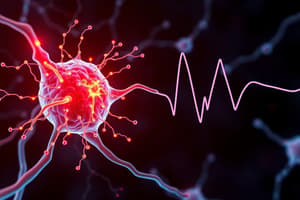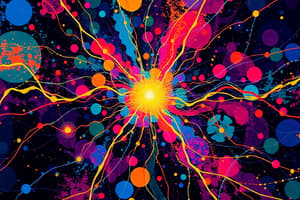Podcast
Questions and Answers
What is the primary function of an action potential in neurons?
What is the primary function of an action potential in neurons?
- To maintain resting membrane potential
- To facilitate the movement of nutrients into the neuron
- To propagate electrical signals along the axon (correct)
- To enhance cellular metabolism
What typically characterizes the resting membrane potential of neurons?
What typically characterizes the resting membrane potential of neurons?
- It is constantly neutral at 0mV
- It is positive due to ion movement
- It is negatively charged at around -70mV (correct)
- It fluctuates frequently throughout the day
Which ion is predominantly found outside the neuron during resting potential?
Which ion is predominantly found outside the neuron during resting potential?
- N+ (correct)
- K+
- Cl-
- -ve charged protein molecules
What happens to the membrane potential when a neuron is stimulated?
What happens to the membrane potential when a neuron is stimulated?
During the action potential process, which ion is primarily responsible for repolarization?
During the action potential process, which ion is primarily responsible for repolarization?
What occurs at -45mV in photoreceptors during the process of an action potential?
What occurs at -45mV in photoreceptors during the process of an action potential?
Why do neurons maintain a resting membrane potential of -70mV?
Why do neurons maintain a resting membrane potential of -70mV?
Which type of ion is most associated with creating a net negative charge inside the neuron?
Which type of ion is most associated with creating a net negative charge inside the neuron?
What is the ratio of sodium (Na$^+$) pumped out to potassium (K$^+$) pumped in according to the given content?
What is the ratio of sodium (Na$^+$) pumped out to potassium (K$^+$) pumped in according to the given content?
Which ion influx is primarily responsible for initiating the threshold potential?
Which ion influx is primarily responsible for initiating the threshold potential?
What triggers the opening of sodium channels in neurons?
What triggers the opening of sodium channels in neurons?
Where do neurotransmitters bind to initiate action potential in the next neuron?
Where do neurotransmitters bind to initiate action potential in the next neuron?
What is the primary consequence of Na$^+$ influx during the action potential process?
What is the primary consequence of Na$^+$ influx during the action potential process?
The action potential is primarily initiated when which of the following events occurs?
The action potential is primarily initiated when which of the following events occurs?
What is required for a neuron to fire?
What is required for a neuron to fire?
What occurs when a neuron reaches threshold potential?
What occurs when a neuron reaches threshold potential?
What is true about the interval after a neuron fires an action potential?
What is true about the interval after a neuron fires an action potential?
How does the propagation of an action potential act in terms of direction?
How does the propagation of an action potential act in terms of direction?
What must happen to initiate a second action potential after one has occurred?
What must happen to initiate a second action potential after one has occurred?
What causes the refractory period in neurons?
What causes the refractory period in neurons?
Which of the following describes the effect of reaching threshold potential on the neuron's state?
Which of the following describes the effect of reaching threshold potential on the neuron's state?
What happens to sodium channels after they are inactivated?
What happens to sodium channels after they are inactivated?
What characterizes the action potential in terms of interval and response?
What characterizes the action potential in terms of interval and response?
What effect does depolarization have on the likelihood of firing in a neuron?
What effect does depolarization have on the likelihood of firing in a neuron?
How does hyperpolarization affect a neuron's ability to fire?
How does hyperpolarization affect a neuron's ability to fire?
Which factor does NOT influence whether a neuron will fire an action potential?
Which factor does NOT influence whether a neuron will fire an action potential?
Which statement is true regarding action potentials and the refractory period?
Which statement is true regarding action potentials and the refractory period?
Which ion's channels play a critical role in the generation of action potentials?
Which ion's channels play a critical role in the generation of action potentials?
What role do neurotransmitters play in neuronal signaling?
What role do neurotransmitters play in neuronal signaling?
What is the primary function of the inactivation gate of sodium channels?
What is the primary function of the inactivation gate of sodium channels?
What effect does stimulation have on photoreceptors?
What effect does stimulation have on photoreceptors?
What is the nature of the hyperpolarization in photoreceptors?
What is the nature of the hyperpolarization in photoreceptors?
What is the role of excitatory postsynaptic potentials (EPSP)?
What is the role of excitatory postsynaptic potentials (EPSP)?
What is the effect of inhibitory postsynaptic potentials (IPSP)?
What is the effect of inhibitory postsynaptic potentials (IPSP)?
Which factors determine the action of neurotransmitters on subsynaptic membranes?
Which factors determine the action of neurotransmitters on subsynaptic membranes?
What happens during the inhibitory action of IPSP on a target cell?
What happens during the inhibitory action of IPSP on a target cell?
Flashcards are hidden until you start studying
Study Notes
Acknowledgement
- The University of Western Australia is located on Noongar land, recognizing the cultural custodianship of Noongar people.
Objectives
- Understand mechanisms of action potential.
Action Potential Overview
- An action potential involves the propagation of electrical signals along the axon.
- Key ionic players include sodium (Na+), potassium (K+), chloride (Cl-), and negatively charged protein molecules.
Resting Membrane Potential
- Neurons have a resting membrane potential of approximately -70mV.
- Photoreceptors exhibit a resting potential of around -45mV.
- More Na+ ions are outside the neuron than inside, contributing to a net negative charge.
- Sodium-potassium pump functions by expelling 3 Na+ ions for every 2 K+ ions imported.
Steps Involved in Action Potential
- Initiation occurs when neurotransmitters from one neuron interact with receptors on another neuron's dendrites, generating a threshold potential.
- A significant influx of Na+ ions leads to depolarization, triggering the action potential.
- Neurons fire only if the threshold potential is reached; otherwise, no action potential occurs.
Propagation of Action Potential
- Action potentials travel in a unidirectional manner along the axon.
- The refractory period prevents the initiation of another action potential immediately after the first.
- Sodium channels become inactivated and unresponsive to stimuli during this period.
Graded and Hyperpolarized Potentials
- Graded potentials influence the likelihood of an action potential, with hyperpolarization moving the membrane potential away from the threshold.
- In photoreceptors, stimulation leads to hyperpolarization and decreased glutamate release.
Neurotransmitters and Ion Flow
- Excitatory postsynaptic potential (EPSP) increases the chance of an action potential in the next neuron.
- Inhibitory postsynaptic potential (IPSP) decreases the likelihood of an action potential occurring.
- Subsynaptic currents from neurotransmitter actions can either add or remove charge from the postsynaptic membrane.
- The effectiveness of neurotransmitters depends on hydrated ion sizes and electric charge, not their chemical nature.
Summary
- Neuronal structure is critical for information propagation both along and between neurons.
- Glial cells play a supportive role in the retina, alongside major neurotransmitters influencing visual processing.
Studying That Suits You
Use AI to generate personalized quizzes and flashcards to suit your learning preferences.




